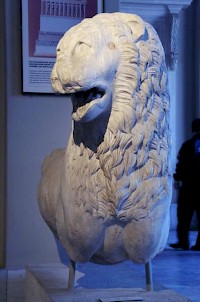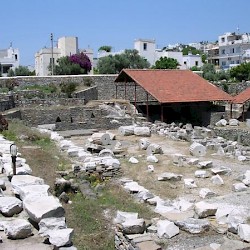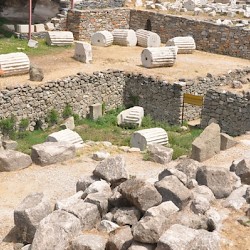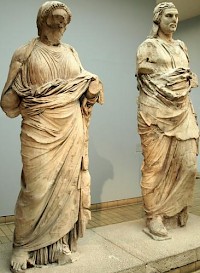Mausoleum of Halicarnassus
Q45368Halicarnassus (Greek Ἁλικαρνασσός): Greek-Carian city, modern Bodrum in southwestern Turkey. The Mausoleum, the tomb of a ruler named Maussolus, was one of the seven wonders of the ancient world.

Maussolus, the satrap of Caria, refounded Halicarnassus (modern Bodrum in southwestern Turkey) and made it his capital. In the Greek world, it was not unusual that a city founder (ktistes) received cultic honors and a tomb on the central square of the new town, and this also happened to Maussolus. After his death in 353 BCE, his wife Artemisia succeeded him and invited Greek artists to build a fitting tomb.
The result was not just a fitting monument, it was one of the Seven Wonders of the Ancient World. Although the mausoleum itself was constructed of bricks, this was covered with splendid white Proconnesian marble. The impressive monument was copied on several occasions. It is likely that the tomb of Alexander the Great in Alexandria and the Belevi Mausoleum were inspired by the building in Halicarnassus, which was known as the mausoleum.

The building was designed by the famous architects Satyrus and Pytheos, who were inspired by traditional Anatolian and Greek architecture (cf. the Monument of the Nereids in Xanthus) and later wrote a book on the monument they had created. This book was known to Roman authors like Pliny the Elder, who offers a description of the Mausoleum hof Halicarnassus.
He says that four famous sculptors were involved: Scopas, Bryaxis, Timotheus, and Leochares, who were responsible for the decoration on the east, north, south, and west side. They made brilliant reliefs of an Amazonomachy, i.e. a battle between Greek warriors and Amazons. Pliny says:
Before their task was completed, Queen Artemisia died. The four sculptors did not leave their work, however, until it was finished, considering that it was at once a memorial of their own fame and of the sculptor's art. And, to this day even, it is undecided which of them has excelled.

From the bottom to the top, there was a large substructure (32x26 meter), a level that was surrounded by thirty-six columns (the Pteron), and, on top of it, Pliny says:
There is a pyramid erected, equal in height to the building below, and formed of twenty-four steps, which gradually taper upwards towards the summit.
Between the columns of the Pteron, there must have been many statues, and at the base of the pyramid, there were twenty-four lions. On the corners of the pyramid were statues of horsemen. Finally, on top of the monument was, according to Pliny,
a platform, crowned with a representation of a quadriga (four-horse chariot) by Pythis. This addition makes the total height of the work one hundred and forty feet.
The monument was surrounded by an enclosure (temenos).
Today, the remains of this once grandiose monument offer a sad sight. The site did suffer already in Antiquity, but in the Middle Ages, the ruin was still impressive. However, the proud tower was ultimately destroyed by the Rhodian knights in 1522. As a result, stones of the monument can today be found in the Castle of Bodrum.
 Halicarnassus, Mausoleum, Lion |
 Halicarnassus, Mausoleum, General view |
 Halicarnassus, Mausoleum, Chamber |
 Halicarnassus, Mausoleum, Relief of an amazonomachy |

Two of the surviving statues, which may have stood right above the entrance in the east, between the columns of the Pteron, are especially striking. It is believed that they represent Artemisia and Maussolus, and were carved by Scopas. Yet, the identification is contested. Anyhow, few people have received a funeral monument that was more impressive than Maussolus'.
The Greek author Lucian could appreciate it: in his Dialogues of the Dead, he made the Carian satrap say,
I have lying over me in Halicarnassus a gigantic monument such as no other dead person has, adorned in the finest way with statues of horses and men, carved most realistically from the best quality marble.
Related
- The Tomb of Mausolus, by W. R. Lethaby







